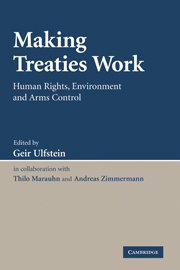Book contents
- Frontmatter
- Contents
- Preface and acknowledgments
- Notes on the contributors
- Table of cases
- Table of treaties and other international instruments
- INTRODUCTION
- PART I INTERNATIONAL HUMAN RIGHTS
- PART II INTERNATIONAL ENVIRONMENTAL LAW
- 5 Dispute resolution, compliance control and enforcement in international environmental law
- 6 The Convention on International Trade in Endangered Species of Wild Fauna and Flora (CITES)
- 7 The Convention on Long-Range Transboundary Air Pollution
- 8 The Convention on Access to Information, Public Participation in Decision-Making and Access to Justice in Environmental Matters (Aarhus Convention)
- 9 The Convention on Environmental Impact Assessment in a Transboundary Context (Espoo Convention)
- PART III INTERNATIONAL ARMS CONTROL
- GENERAL COMMENTS
- Index
6 - The Convention on International Trade in Endangered Species of Wild Fauna and Flora (CITES)
Published online by Cambridge University Press: 05 September 2009
- Frontmatter
- Contents
- Preface and acknowledgments
- Notes on the contributors
- Table of cases
- Table of treaties and other international instruments
- INTRODUCTION
- PART I INTERNATIONAL HUMAN RIGHTS
- PART II INTERNATIONAL ENVIRONMENTAL LAW
- 5 Dispute resolution, compliance control and enforcement in international environmental law
- 6 The Convention on International Trade in Endangered Species of Wild Fauna and Flora (CITES)
- 7 The Convention on Long-Range Transboundary Air Pollution
- 8 The Convention on Access to Information, Public Participation in Decision-Making and Access to Justice in Environmental Matters (Aarhus Convention)
- 9 The Convention on Environmental Impact Assessment in a Transboundary Context (Espoo Convention)
- PART III INTERNATIONAL ARMS CONTROL
- GENERAL COMMENTS
- Index
Summary
Introduction
The 1973 Convention on International Trade in Endangered Species of Wild Fauna and Flora (CITES) is one of the oldest multilateral environmental agreements (MEAs). A specific tool rather than a global solution, it addresses one of the principal causes of biodiversity loss – the international wildlife trade. Since its inception, CITES has been seen as the flagship wildlife agreement. Most perceive it as effective, although there has never been a thorough empirical assessment of the effectiveness of CITES – or of the extent to which it is truly implemented and enforced at national level.
The origin of CITES lies in a 1963 resolution of the General Assembly of the International Union for Conservation of Nature and Natural Resources (IUCN), now the World Conservation Union, calling for ‘an international convention on regulation of export, transit and import of rare or threatened wildlife species or their skins and trophies’. Successive draft texts were prepared and circulated by the IUCN Environmental Law Centre in Bonn, then revised in 1969 and 1971 in light of comments received from governments and non-governmental organizations (NGOs). The IUCN initiative coincided with a US prohibition of imports of wildlife ‘threatened with worldwide extinction’, except for scientific or breeding purposes, under the 1969 Endangered Species Conservation Act. Complaints of competitive disadvantage from US traders led to efforts by the US Government to seek a binding international convention on endangered species conservation.
- Type
- Chapter
- Information
- Making Treaties WorkHuman Rights, Environment and Arms Control, pp. 134 - 160Publisher: Cambridge University PressPrint publication year: 2007
- 2
- Cited by



